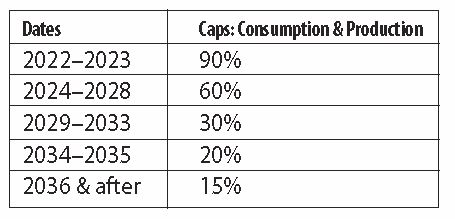Written on: June 1, 2021 by Doug Raymond
American Innovation & Manufacturing (AIM) Act
On April 30, the U.S. Environmental Protection Agency (EPA) Administrator Michael S. Regan signed a proposed rule titled Phasedown of Hydrofluorocarbons: Establishing the Allowance Allocation & Trading Program under the AIM Act. The first regulation proposed under the AIM Act of 2020 is to address the production and consumption of hydrofluorocarbons (HFCs), which are potent greenhouse gases commonly used in refrigerators, air conditioners, aerosol products and many other applications. This proposed rule would set the HFC production and consumption baseline levels from which reductions will be made, establish an initial methodology to allocate HFC allowances for 2022 and 2023 and create a robust, agile and innovative compliance and enforcement system.
The AIM Act, which was included in the Consolidated Appropriations Act of 2021 (stimulus package), directs EPA to phase down production and consumption of HFCs in the U.S. by 85% over the next 15 years. It sets the stage for the U.S.’ ambitious agenda to lead domestically and serve as an example abroad to tackle potent climate pollutants such as HFCs. A global HFC phasedown is expected to avoid up to 0.5°C of global warming by 2100.
To support this rulemaking, EPA is also collecting data on the production, import, export and destruction of bulk HFCs, as well as the use of HFCs solely for:
• propellant in metered dose inhalers;
• defense sprays;
• structural composite preformed polyurethane foam for marine use and trailer use;
• the etching of semiconductor material or wafers and the cleaning of chemical vapor deposition chambers within the semiconductor manufacturing sector; or
• onboard aerospace fire suppression.
Note: EPA Administrator Regan signed the proposed rule on April 30 and EPA is submitting it for publication in the Federal Register (FR). While EPA has taken steps to ensure the accuracy of this Internet version of the rule, it is not the official version of the rule. Please refer to the official version in a forthcoming FR publication, which will appear on the Government Printing Office’s website (govinfo.gov). The documents can be found at:
• HFC Allocation NPRM (PDF)(276 pp, 1 MB)
• HFC Allocation NPRM Fact Sheet (PDF)(4 pp, 316 K)
• HFC Allocation NPRM FAQ (PDF)(9 pp, 560 K)
• Draft Regulatory Impact Analysis for Phasing Down Production & Consumption of Hydrofluorocarbons (HFCs) (PDF)(174 pp, 2 MB)
In addition to the proposed rule, EPA held a workshop on HFC Reclamation on April 26 and took the opportunity to explain the AIM Act and scheduled phasedown, seen below:

EPA will enact a phasedown regulation by Sept. 23. It appeared the reason for this EPA workshop was to elicit comments from companies that reclaim HFCs; EPA fielded numerous questions from the Industry.
State HFC Rules
Even though EPA is working on the AIM Act, numerous States are moving ahead with State HFC regulations:
• Delaware finalized an HFC regulation in March with a Sept. 1, 2021 effective date. Companies using HFC (besides HFC 152a) have to comply with a labeling provision. The best option is to list the propellant on the safety data sheet (SDS) and submit a date code to the agency. All exceptions from the EPA’s Significant New Alternatives Policy (SNAP) program Rule 20 apply.
• Rhode Island has a proposed rule that also keeps in place all the original exceptions from SNAP Rule 20. However, its labeling provision is odd; the way the rule reads currently, only non-compliant uses of HFCs would need to be labeled. Who would do this?
• Virginia—as with Delaware and Rhode Island, all original exceptions from the SNAP Rule 20 are acceptable. A labeling provision is in place for all products that use HFCs for the exceptions. Maintaining consistency throughout these State rules has been a chore for Nicholas Georges of the Household & Commercial Products Association and me on behalf of the National Aerosol Association.
CARB
As previously reported, the California Air Resources Board (CARB) is working on 15-day changes. Two areas that CARB is working on are a definition for monoterpene and the Innovative Product Exemption (IPE) for compressed gases. The 15-day changes will likely be released in July 2021. SPRAY